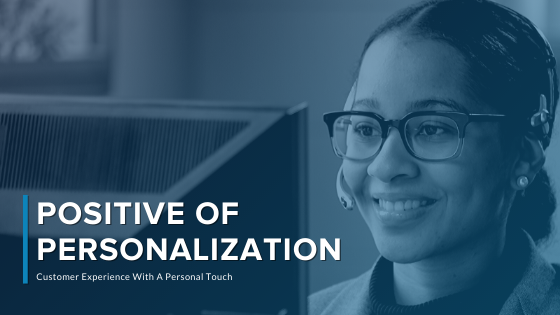
30 Jul The Power of Personalization: Customer Experience With A Personal Touch
Personalization
It’s Monday and you’re going through your morning routine: coffee has been brewed, weekly meetings accepted and now it’s time to tackle your inbox. Just like clockwork, 75 percent of your emails address you as the “Valued Customer.” After reading that uninspired greeting for the sixth time in a row, you start clicking that little trash can icon every time it appears. And this kind of detached communication doesn’t limit itself to emails — it happens everywhere.
Are your customers receiving the same generic, impersonal interactions from your company? Let’s hope not! According to a study conducted by Evergage, 96 percent of marketers agree that personalization advances customer relationships. So let’s see how we can keep your company’s messaging far away from that little trash can of ex-communication.
What Is Personalization
Implementing personalization into your customer’s experience is a lot easier than the seven-syllable word would suggest. We promise it’s not rocket science. But it is all about making each customer believe that you’re talking to them directly — that you know who they are, what their pain points are and what they need. And thanks to today’s technology, you don’t have to go down the social media stalking rabbit hole to find out all of this personal information for each of your thousands of customers.
It ranges from simply inserting customers’ names into emails, to using CRMs (Customer Relationship Management systems) to strategically segment customers and develop different marketing messages tailored for each segment. Even though both strategies will yield an increase in customer experience, the latter option will create more of a dramatic and long-lasting effect.
Personalization in Action
Let’s make this real, let’s say you’re promoting a self-help book called “100 ways to become self-aware”.Rather than promoting the book the same way across all channels, you choose to highlight certain parts of the book depending on the platform. By doing so, you must ask yourself a couple of questions-who are my customers, what problem do they need me to solve and how do they want to communicate with me? What experience does my customer receive?
Asking yourself those questions, allows you to place yourself in the shoes of your customers. From that viewpoint, you will find that promoting specific content that interests a segmented group is immensely greater than marketing to all your customers the same way. Let’s apply that, let’s imagine the second chapter of your book focuses on self-confidence. Would you not agree that creating a social campaign around beauty, confidence, individuality, etc will not only drive book sales, but it can create a deep personal connection to your customer?
If done the right way, the messaging will not come across as an aggressive, insincere and impersonal sale tactic, but will be seen as valuable and relevant to the customer. Companies like Netflix and Amazon are great examples of this technique. When a customer signs into Netflix they are introduced with a personalized greeting. Along with the “Welcome back, (name on the account)” messaging, the customer is presented with a playlist depending on their prior movie choices. Maybe you don’t have the technology of Netflix or Amazon, but personalization can be applied to every customer interaction.
If a sales associate asks a customer’s name and addresses them as such, that’s personalization. If a clerk noticed that a customer is buying shampoo and then promotes the perfect conditioner to pair it with due from their experience, that’s personalization. No matter the scale, adding personalization to your marketing efforts will keep you far from that little trash can by making your customers feel valued, remembered, and special.
Contact us today to elevate your customer experience with Superior Contact’s customer personalization.

Sorry, the comment form is closed at this time.